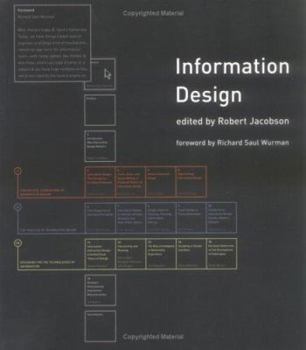Information Design
Select Format
Select Condition 
Book Overview
foreword by Richard Saul Wurman Information design is the newest of the design disciplines. As a sign of our times, when the crafting of messages and meaning is so central to our lives, information design is not only important-it is essential. Contemporary information designers seek to edify more than to persuade, to exchange more than to foist upon. With ever more powerful technologies of communication, we have learned that the issuer of designed...
Format:Hardcover
Language:English
ISBN:026210069X
ISBN13:9780262100694
Release Date:June 1999
Publisher:MIT Press (MA)
Length:373 Pages
Weight:2.15 lbs.
Dimensions:1.1" x 8.3" x 9.3"
Related Subjects
Arts, Music & Photography Communication Computer Science Computers Computers & Technology Engineering Game Programming Graphic Design Graphics & Visualization History & Criticism Modeling & Simulation Networking Networks, Protocols & APIs Programming Science & Math Techniques Technology Textbooks Words, Language & GrammarCustomer Reviews
5 ratings
Heavy reading
Published by Thriftbooks.com User , 23 years ago
This book consists of a series of cross-disciplinary articles on information design. In the concluding chapter of the book, Jeff Raskin summarizes the volume by saying "I find that [the articles] accurately represent the diversity of the field - - from fuzzy New Age touchy-feely rantings to thoughtful studies." I'm inclined to agree, but fortunately, the thoughtful studies outnumber the rantings. I was fascinated most by Whitehouse's article on architectural signposting for the blind. However, many of the other articles were also exceptionally thought-provoking. Before I read this book, I thought "information design" had something to do with drawing effective graphs. But after reading these articles, I would say it is making meaning by revealing the relationships between data through planned presentation. Or something to that effect- -the field is much wider than I had ever thought before.
Illustrates Why Info Design Is More Than Just Flowcharts
Published by Thriftbooks.com User , 24 years ago
I am a professional Information Architect; However, I picked up the book without any preconcieved notions or superficial expectations. I found especially illuminating (and actually empathisized with) the comparisons between IAs conceptualizing Information Design and Traditional Architects conceptualizing "wayfinding" through building structures. For those of you who are looking for a Home Deopt style "How-To" manual on creating intuitive interface design for software applications; you simply have to surf the web for 1001 lessons on HOW NOT TO do it. Seriously, the only effective Information Design training program is years of experience in software development. A "blueprint" or plan is key to useful execution, but there is a lot more to good Information Design than a pile of flowcharts. The best an author can do is to share some of his/her insight on ergonomic design with the rest of us. While many of the reviewers found this book's exposition of visionary and philosophical approaches to design impractical; I found it to be both informative and refreshing. Information design is not about how rigidly organized the branching structure is; instead, it's about how the user "moves through" an application (hopefully with pleasure and ease of use). This calls for a combination of clever engineering and artistic design, and cannot be accomplished simply by "keeping all your ducks in a row" The most significant aspect of good Info Design, in the end, is clear, intuitive, useable interface.
The nay-sayers below just don't get it.
Published by Thriftbooks.com User , 25 years ago
Don't read this book with the wrong expectations. This isn't a book about how to do information design. This is a book about being an information designer: theories, ethics, political and cultural issues, etc. I agree, the visual design is less than eloquent: standard MIT Press "academic." But the writing is exciting, so long as you're not looking for a how-to book. In fact, it's one of the lessons of this book that, so far as information design goes, our understanding of ID is still evolving and an how-to ID book would be premature.
Now I know why I'm an information designer.
Published by Thriftbooks.com User , 25 years ago
Aside from a wonderful dustjacket, this book unfortunately lacks real design and visual style. But don't let that put you off. This book travels a lot of time and space, most of it well -- from the history of Egyptian scribes to the future of online virtual worlds!I'd have preferred two or three volumes to one try-to-be-everything text. Also, I sense a need for a magazine or online journal, to bring things up to immediate date. But overall, I was plenty impressed and satisfied with this book.Clement Mok, a personal fav rave, on the dustjacket calls ID the "design of understanding." This book does a good job of it.
An intriguing look at the life of the information designer.
Published by Thriftbooks.com User , 25 years ago
Unlike the previous reviewer, I actually read the book and especially its introduction. INFORMATION DESIGN fulfills its promise: it reveals what it means to be an information designer at an ethical, even emotional level. I was especially impressed by the diversity of the contributors and their willingness to express doubts as well as hopes for this emerging profession. INFORMATION DESIGN isn't exclusively a how-to book. More importantly, it helped me to understand what information design is and why it's done in the first place. This is a must-read for those of you who aspire to become or already are information designers. You have your work cut out for you!






